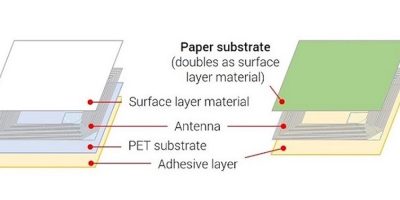Eco-friendly NFC tag has paper-based antenna substrate
A paper-based antenna substrate for an NFC tag label is an environmentally-friendly option for asset tracking that has been developed by Toppan.
It has communication performance equivalent to products using plastic film but uses new circuit fabrication technology. The design also prevents fraudulent reattachment from the antenna breaking when the label is removed. One of the advantages of using paper as a substrate is that the NFC tag label is designed to break when it is removed, making communication impossible.
The eco-friendly near-field communication (NFC) tag label replaces conventional polyethylene terephthalate (PET) film as a substrate for the antenna with paper material.
Aluminium foil with low electrical resistance is used to form an antenna on a paper substrate via a new circuit fabrication technology combining laser edge technology with a roll-to-roll web handling process. This eliminates plastic from the NFC tag while maintaining the required communication performance. If a paper substrate is used instead of a PET film substrate for a million standard size NFC tag labels (80 x 45mm), consumption of plastic resin can be reduced by approximately 110kg.
Due to a layer structure in which the paper substrate doubles as the surface layer material, the eco-friendly NFC tag label is 30 per cent thinner than Toppan’s existing products with PET film substrates. This means that documents or the like to which NFC tag labels have been attached do not become bulky when stacked.
In addition to reducing plastic consumption to zero by switching to paper, the new circuit fabrication technology ensures sufficient communication performance as an NFC device.
The value of the global NFC tag market was estimated to be US$3.8 billion in 2020 and is expected to reach US$15.5 billion by 2030. This increase is driven by the increased use in contactless payment systems and supply chain management.
NFC tag labels are predominantly produced by using metal foil to form an antenna on a plastic substrate. Replacing plastic with paper materials reduces the environmental impact but has been challenged by insufficient communication performance because the electrical resistance of circuits increases when printing methods employing conductive inks, such as widely-used silver nanoparticles, are used to form antennas on paper.
“Toppan’s new NFC tag label meets growing demand for more eco-friendly solutions as the NFC market expands globally,” said Takamitsu Nakabayashi, general manager of RFID/IoT and security development in Toppan’s DX Design Division.
Established in Tokyo in 1900, Toppan is committed to delivering sustainable, integrated solutions in fields including printing, communications, security, packaging, décor materials, electronics, and digital transformation.




